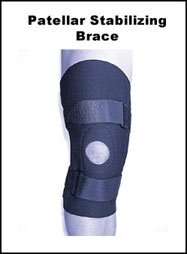In order to better understand patellar instability and why the knee cap (patella) dislocates it is important to understand the anatomy and function of the knee and the patella. Please review the section on knee anatomy prior to reviewing this section. Reviewing the section on patellofemoral pain may also be helpful.

What is the patella?
The kneecap (patella) is a small bone in the front of the knee. It glides up and down the groove in the thigh bone (femur) as the knee bends and straightens. The patella has a smooth coating (articular cartilage) on its underside which allows it to slide easily in this groove. The groove in the femur is called the femoral groove and it is also coated with articular cartilage. The patellar tendon is a thick, ropelike structure that connects the bottom of the patella to the top of the large shin bone (tibia).
What muscles connect to the patella?
The powerful muscles on the front of the thigh, the quadriceps muscles, straighten the knee by pulling at the patellar tendon via the patella. One of the quadriceps muscles, the vastus medialis, pulls the patella inward (medially). Another quadriceps muscle, the vastus lateralis, pulls the patella outward (laterally). There are also smaller rope-like structures (ligaments) on the inner (medial) and outer (lateral) sides of the patella. These small ligaments work with the quadriceps muscles to help keep the patella from coming out of the femoral groove.
What is patellar (kneecap) dislocation?
When the patella comes completely out of the femoral groove it is called a patellar dislocation. Occasionally the patella will only partly come out of the groove. This is called a patellar subluxation. Patellar subluxations can be thought of as “mild dislocations”. Most of the time the patella dislocates or subluxes outward (laterally). The medial patellar ligament and the vastus medialis muscle are important structures in preventing the patella from dislocating or subluxing laterally. When the patella dislocates or subluxes laterally, these structures are usually damaged.
What is patellar instability?
As a result of one or more patellar dislocations or subluxations, the knee can feel unstable. This type of problem is called patellar instability. This feeling of instability occurs because the muscles and ligaments are unable to keep the patella in the femoral groove.
What does patellar dislocation feel like?
Initially, people who dislocate their patella complain of sudden pain in their knee after a plant and twist type of injury or after a contact injury. Sometimes straightening the knee will help the patella go back in the femoral groove. Sometimes the patella stays out of the groove and has to be put back in by a specialist. Regardless, the knee usually swells and sometimes it feels unstable. With lateral patellar dislocations a tear in the medial patellar ligament or the vastus medialis muscle may be felt. The patella may also be slightly displaced to the outside (laterally) or feel like it is going to dislocate again if pushed laterally. Finally, it may be difficult to bend and straighten the knee without pain.
How do you test for patellar dislocation or instability?
Examination techniques that detect excessive movement of the patella in the femoral groove are helpful in determining if there has been a patellar dislocation or if there is ongoing patellar instability. X-rays are often done at the time of the injury to make sure that the bones of the knee are not broken or chipped. Other tests such as Magnetic Resonance Imaging (MRI) are occasionally used to rule out damage inside the knee.
How do you treat patellar dislocation or instability?
The treatment of patellar dislocations and patellar instability depends on the severity of the injury and other associated injuries. Each treatment plan should be individualized. Initially, protection (by use of crutches and a rehabilitation brace), rest, ice, compression and elevation (PRICE) of the injured knee will help reduce pain and/or swelling.
After a patellar dislocation or subluxation the long term goal is to return the individual back to their previous level of activity. Achieving this goal will depend on the function and stability of the knee. A general knee rehabilitation program which includes strengthening exercises, flexibility exercises, aerobic conditioning, technique refinement and proprioceptive (biofeedback) retraining is the most important factor in improving knee function and stability. Stability may be improved by a patellar stabilizing brace. Rarely, surgery is required.
Even with the most ideal treatment the knee may never be as “normal” as the uninjured knee and modification of activity may be required. Furthermore, some research has identified that individuals who have repetitive patellar dislocations are at greater risk for premature “wear and tear” arthritis (osteoarthritis) of the knee joint. However, doctors and physiotherapists trained in treating patellar dislocations and patellar instability can outline a treatment plan specific to each individual.
To read more about patellar stabilizing braces click here. Please visit the links section for additional information on patellar dislocations and patellar instability. Links have been provided to other websites as well as online medical journals. Other knee injury topics can also be accessed.
